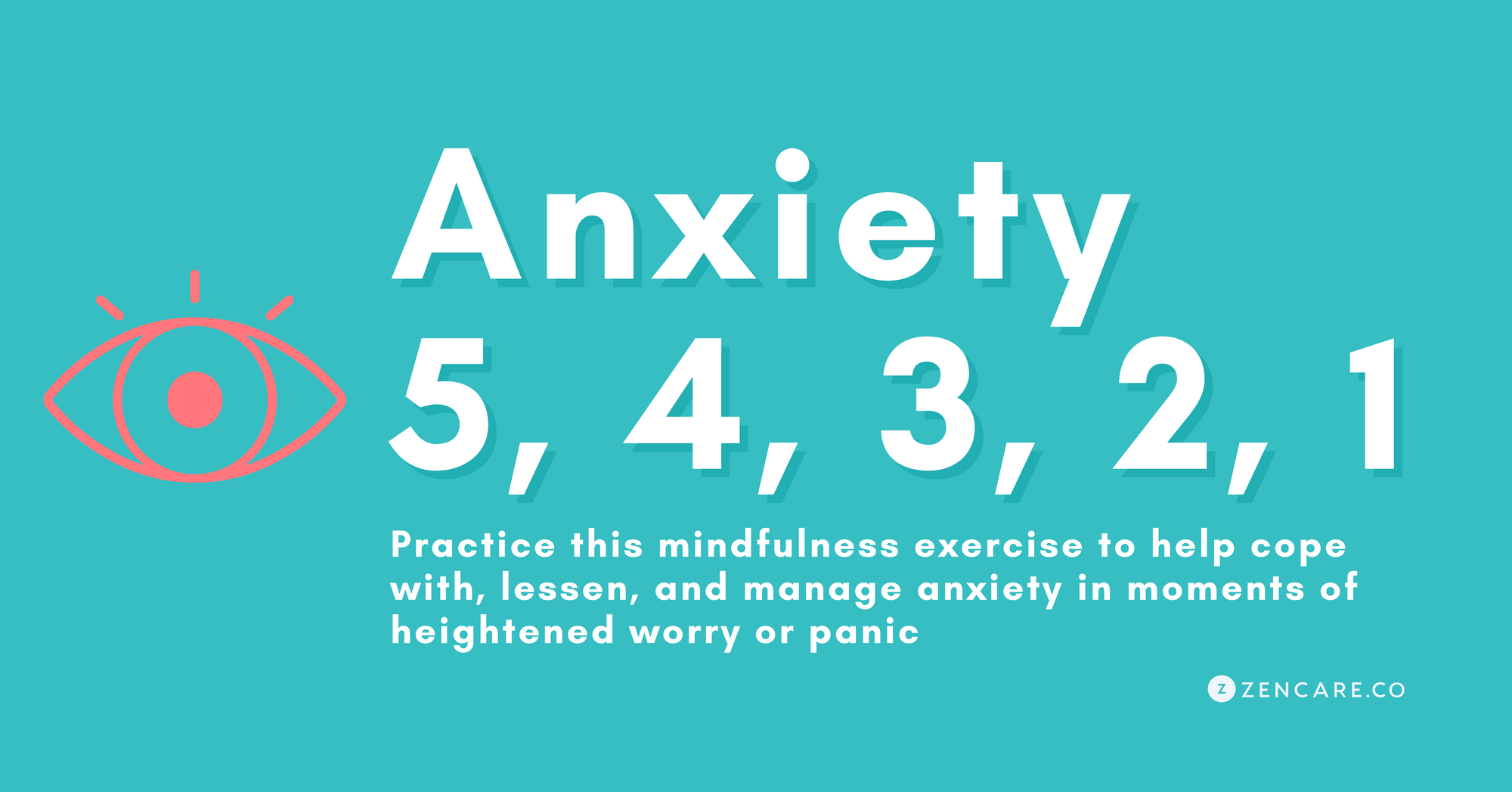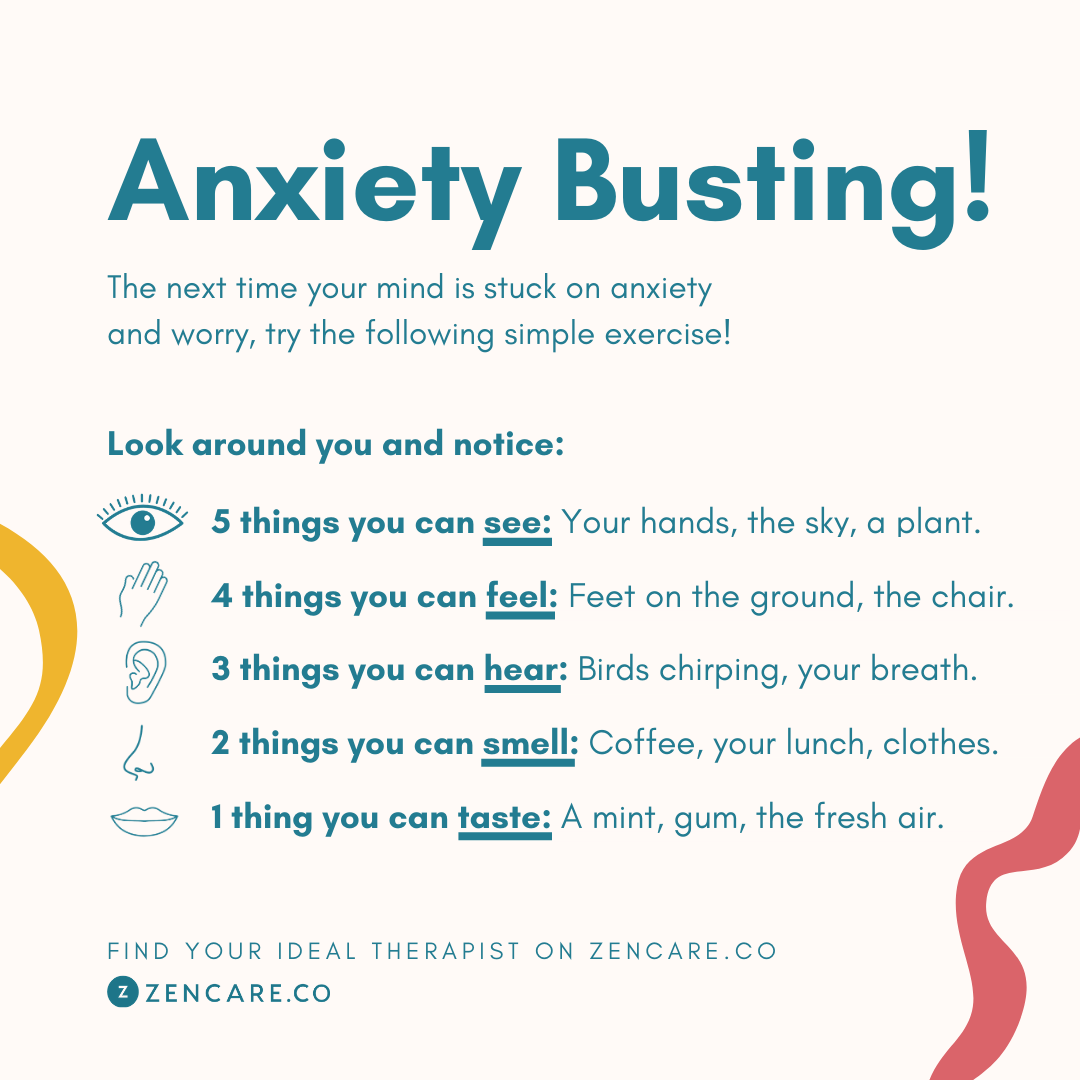Anxiety 5, 4, 3, 2,1 is a mindfulness exercise used to cope with, lessen, and manage anxiety. This grounding technique can help increase awareness and decrease intrusive thoughts in moments of heightened anxiety, worry, or panic attacks.
Anxiety is something we’ve all experienced in our lives. We often feel the sensation of butterflies in our stomachs before making an important presentation at work. Some people feel shortness of breath or heart-pounding when taking off on an airplane or driving over a bridge. These are all characteristics of anxiety that the Anxiety 5, 4, 3, 2, 1 technique can help with.

Anxiety 5, 4, 3, 2, 1 technique
In short, the Anxiety 5, 4, 3, 2, 1 technique works by following these simple steps:
Start by bringing your attention to your breathing, and taking deep, slow breathes.
- Notice FIVE (5) things you can see in your surrounding area. These may include the blue sky, a cloud, a plant, the chair, a pen, a cup, the table, a person, or anything in your surroundings.
- Notice FOUR (4) things you can touch near you. This could be the floor, the wall, your hair, your clothes, the sweat on your palms, or the coolness of a glass of water.
- Notice THREE (3) sounds you can hear. This could be birds chirping in the background, construction, a car driving nearby, or music far away.
- Notice TWO (2) scents you can smell. This could include the smell of flowers nearby, your tea, fresh-cut grass, your clothes, or simply the smell of the space you are in. Can’t find anything to smell? Consider taking a short walk outside to smell nature, to the kitchen for food smells, or to the bathroom for soap.
- Notice ONE (1) flavor you can taste. This can be a tough one – but it can be as simple as the taste of your tongue! Can you taste the coffee from the morning, your lunch, or a mint that you had?
The Anxiety 5, 4, 3, 2, 1 exercise can also be used as an imagery technique. If you are fearful of flying and you’re on an airplane preparing for takeoff, acknowledging the sights and sounds around you could actually cause you to feel more nervous. You may want to imagine the destination ahead instead! Imaging the feeling of your toes in the sand, the smell of the ocean breeze, or the taste of your favorite comfort food could be more helpful.
How Anxiety 5, 4, 3, 2, 1 works
The Anxiety 5, 4, 3, 2, 1 technique is grounded in mindfulness, which helps calm the nervous system.
By shifting your attention from focusing on the causes of anxiety to being curious about your present sensations, the technique encourages you to change your brain’s response to stress in two important ways.
First, it helps your body feel more connected to your existence in the present moment – and grounding can be a hugely beneficial counter to anxiety.
Second, by focusing on sensory curiosity about the world, you are reminding yourself to view the world in a curios, open, non-judgmental way. Together, these shifts help decrease the “fight or flight” response that causes anxiety.
In addition to mindfulness practices, the Anxiety 5, 4, 3, 2, 1 technique is also used in cognitive behavioral therapy, commonly known as CBT, which emphasizes teaching individuals behavioral skills such as relaxation techniques and guided imagery to use in moments of increased stress or anxiety. Learn more about CBT below.
When To Use Anxiety 5, 4, 3, 2, 1
The Anxiety 5, 4, 3, 2, 1 technique can be used to combat anxiety in a multitude of situations. Here are a few examples:
- Nervousness at work before a presentation or meeting
- Social anxiety before a date or group gathering
- Worry and nervousness that feels out of control
- Fears related to boarding a flight, boat, or subway
- If you are feeling the onset of a panic attack
What can Anxiety 5, 4, 3, 2, 1 help with?
The Anxiety 5, 4, 3, 2, 1 technique can help with more than just generalized anxiety. Here are a few conditions and challenges that the tool can help with:
- Anxiety
- ADHD
- Anger Management
- Chronic Pain
- OCD
- Panic Attacks
- Phobias
- Social Anxiety
- Stress Management
- Writer's Block
Consider seeking support from a therapist
Anxiety 5, 4, 3, 2, 1 can be used by anyone experiencing anxiety. That said, if anxiety is significantly debilitating and impacting your life, consider working with a therapist to address your anxiety.
If you found this exercise helpful and want to develop more mindfulness practices and anxiety-busting techniques like these, a therapist who specializes in skill-based therapy such as the following may be a great fit for you:
- Cognitive Behavioral Therapy – CBT is a skills-based therapy that helps bring awareness to how unhelpful thought patterns or beliefs impact your emotions and behavior. CBT has been shown to be effective in reducing anxiety by providing behavioral techniques to restructure cognitive distortions.
- Dialectical Behavioral Therapy – DBT is a skills-based therapy that can be used to decrease anxiety by strengthening skills such as mindfulness, distress tolerance, and emotional regulation.
- Mindfulness Based Stress Reduction – MBSR is a group therapy that can be used to decrease anxiety by using mindfulness exercises to manage stressful situations.
New to therapy? Learn about how to find a therapist here.
